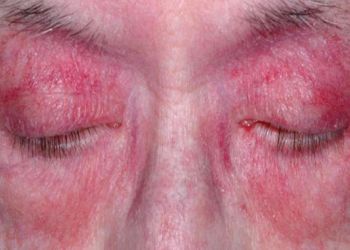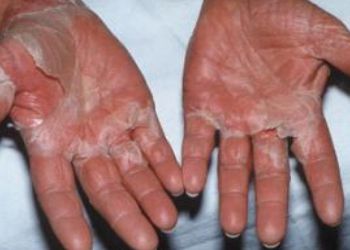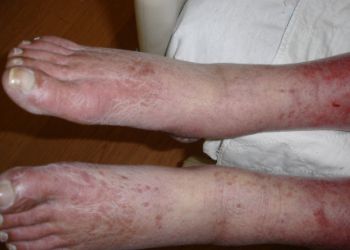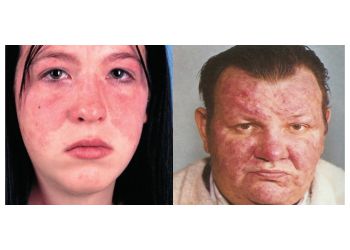Services
Dermatomyositis and Polymyositis




What are myopathies?
Myopathy is the medical term for muscle disease. Some muscle diseases occur when the body’s immune system attacks muscles. The result is misdirected inflammation, hence the name inflammatory myopathies. This damages muscle tissue and makes muscles weak.
People with inflammatory myopathies may have these features:
- Weakness in the large muscles around the neck, shoulders and hips
- Trouble climbing stairs, getting up from a seat, or reaching for objects overhead
- Little, if any, pain in the muscles
- Choking while eating or aspiration (intake) of food into the lungs
- Shortness of breath and cough
The inflammatory myopathies include polymyositis and dermatomyositis. Muscle inflammation and weakness occur in both conditions while patients with dermatomyositis also have a rash. This rash of dermatomyositis most often appears as purple or red spots on the upper eyelids or as scaly, red bumps over the knuckles, elbows or knees. Children with the disease also may have white calcium deposits in the skin called calcinosis. Sometimes patients can have the rash with no sign of muscle disease. This form of the disease is called an amyopathic dermatomyositis. People with dermatomyositis may also have lung inflammation that causes cough and shortness of breath.
What causes myopathies and who gets them?
There are many causes of muscle disease other than inflammation. They include infection, muscle injury due to medicine, inherited diseases that affect muscle function, disorders of electrolyte levels, and thyroid disease. It is unknown what causes inflammatory myopathies. One of the most accepted theory is that
something goes wrong in the immune system, which leads to attack of the “self’ and muscle inflammation.
Inflammatory myopathies are rare. Polymyositis and dermatomyositis occur in about one person per 100,000 population.
All ages can get these diseases. The peak periods include ages 5 to 10 years in children, and 40 to 50 years in adults. Women get inflammatory myopathies about twice as often as men. These diseases affect all ethnic groups. No one can predict who will get an inflammatory myopathy.
How are myopathies diagnosed?
A doctor suspects myopathy when patients complain of trouble doing tasks that require muscle strength, or when they get certain rashes or breathing problems. Most people with myopathy have little or no pain in their muscles. A doctor will do a muscle strength exam to find if true muscle weakness is present. A biopsy of a weak muscle may also be required for diagnosing this condition. (That is, a small piece of muscle tissue is removed for testing under local anesthesia & it is safe). In older adults, dermatomyositis and, to a much lesser extent, polymyositis at times may be linked to cancer. Therefore, all adults with these diseases should have tests to rule out cancer, although it is rare.
How are myopathies treated?
Medicines are given to control the inflammation in the muscles and this includes corticosteroids. Most patients regain muscle strength in 2-3 months. The side effects of corticosteroids include weight gain and redistribution of body fat, thinning of the skin, osteoporosis, and cataracts. Even muscle weakness can be a side effect. Because patients taking prednisone are at risk for osteoporosis, they should receive proper treatment to prevent it. Your doctor likely will add another drug to your treatment plan. This gives better long-range control of the disease and helps avoid long-term side effects of corticosteroids. Patients whose disease is severe or who do not respond to standard treatment have other options. Methotrexate, Mycophenolate &
Azathioprine are other drugs that help reduce steroids, while benefits are preserved.
Physical therapy: Physical therapy can help patients with muscle disease lead active lives. Physical therapy and exercise are important in the treatment of muscle disease
Do’s and Don’ts
- Myopathies are chronic (long-term) diseases. To help control your illness, it is important to practice good health measures. Eat a healthy, well-balanced diet, exercise and try to keep a healthy weight.
- If you have a dermatomyositis rash, protect yourself from the sun. This is because the rash gets worse after sun exposure, for reasons that are not clear. Therefore, limit time outdoors, and put on sunscreen 30 minutes before you go outside.
- If you have trouble swallowing, eat soft or semisolid foods, or puree your solid foods. To prevent choking if you are bedbound, you should be seated up in bed to eat.
People with myopathy may look healthy and normal. It is important for employers, teachers and family members to understand the limits that muscle weakness causes in people with myopathy.
Regular blood tests to monitor disease & medication effects, physiotherapy as taught by your treating doctors team & regular follow up to adjust medications is must on a long term basis.
